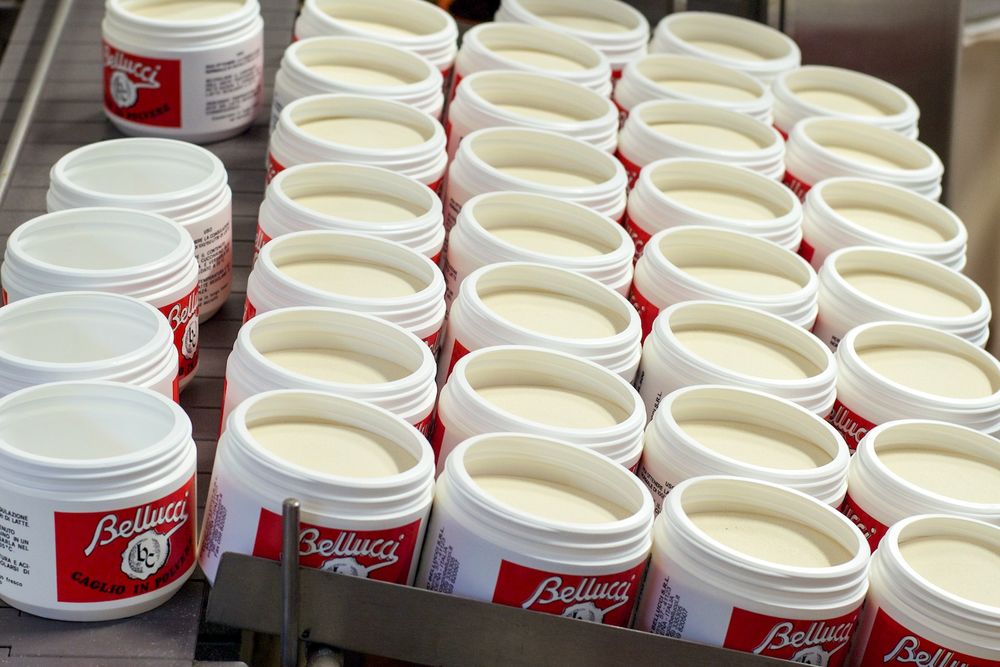What is Rennet?
Rennet is a complex set of enzymes, primarily chymosin (or rennin), that’s responsible for coagulating milk, separating it into solid curds and liquid whey. This separation is the very first step in the cheese-making process. Without rennet, milk would remain a liquid, and we’d miss out on the magical transformation that turns it into cheese.
Rennet traditionally comes from the stomach lining of ruminant animals—mainly calves, lambs, or kids (baby goats). The enzymes in rennet work to break down the proteins in milk, causing it to thicken and form curds. These curds are then processed and aged to become the cheese we know and love.
Fun Fact: How Did We Discover Rennet?
Legend has it that rennet was discovered accidentally thousands of years ago when ancient humans stored milk in the stomachs of animals during long journeys. When they arrived at their destination, they found that the milk had turned into curds and whey. Thus, cheese was born!
Types of Rennet
In today’s modern cheese-making world, there are several types of rennet available. Let’s take a look at the four main categories:
1. Animal Rennet
Animal rennet, derived from the stomach lining of young animals, is the traditional form used in cheese-making. It’s considered to produce superior-tasting cheeses, particularly for aged varieties like parmesan or gouda. Animal rennet has been used for thousands of years and remains popular with artisanal cheese-makers.
Pro: Rich flavor in aged cheeses.
Con: Unsuitable for vegetarians.
2. Vegetable Rennet
As the name suggests, vegetable rennet comes from plant sources that mimic the action of animal rennet. Certain plants, such as thistles, nettles, and figs, contain coagulants that can thicken milk in a similar way.
Pro: Suitable for vegetarians.
Con: It can sometimes result in a slightly bitter aftertaste, especially in aged cheeses.
3. Microbial Rennet
Microbial rennet is produced from molds and bacteria. While it doesn’t come from animal sources, it offers an affordable and consistent option for cheese-makers. Most mass-produced cheeses you’ll find at the grocery store are made with microbial rennet.
Pro: Affordable and vegetarian-friendly.
Con: Can produce inconsistent results and may lack the rich flavor of traditional cheeses.
4. Genetically Engineered Rennet (FPC)
Fermentation-produced chymosin (FPC) is a genetically engineered version of rennet. Scientists can now insert genes from animals into microbes, allowing them to produce rennet enzymes without using animals. This type of rennet is incredibly consistent and has been embraced by many in the cheese industry due to its efficiency.
Pro: Highly consistent and suitable for vegetarians.
Con: Some people prefer to avoid genetically modified products.
The Role of Rennet in Cheese-Making
Rennet plays a starring role in transforming milk into cheese. Once added to the milk, the rennet enzymes begin to break down casein proteins, which are responsible for holding milk together in its liquid state. As the casein is broken down, the milk separates into solid curds and liquid whey.
The curds are the foundation of cheese. After separating them from the whey, they are shaped, salted, and aged to develop their flavor and texture. Different amounts of rennet and varying aging techniques create the wide array of cheeses that we enjoy today.
The Science Behind It
The enzyme chymosin is the most important in rennet, as it specifically targets the kappa-casein proteins in milk. Kappa-casein helps stabilize the milk, and chymosin breaks it down, allowing the milk to coagulate. The fascinating part is that it works best at a specific temperature (around 30-35°C or 86-95°F), which is why cheese-makers carefully control the conditions when making cheese.
Is Rennet Vegetarian or Vegan?
Many people are concerned about whether the cheese they consume is suitable for their dietary preferences. Traditionally, animal rennet is not considered vegetarian because it comes from the stomachs of animals. However, with the rise of vegetable, microbial, and genetically engineered rennets, vegetarians now have more options.
Unfortunately, fully vegan cheese that uses no animal or animal-derived enzymes is still quite a challenge in terms of flavor and texture. Some vegan cheeses rely on non-rennet coagulants like lemon juice or vinegar, but the results are often less rich and creamy.
Rennet in Different Types of Cheese
The type of rennet used can have a significant impact on the flavor, texture, and aging process of the cheese. Here’s a look at some popular cheeses and the rennet used to make them:
- Parmesan: Always made with animal rennet. In fact, by law, parmesan must be made using traditional methods, including the use of animal rennet.
- Cheddar: Can be made with animal or microbial rennet, depending on the producer.
- Mozzarella: Traditionally made with animal rennet, but vegetarian versions using microbial or vegetable rennet are now widely available.
- Brie & Camembert: Soft cheeses like these often use microbial rennet, although artisanal varieties may use animal rennet for a richer flavor.
The Ethical Debate Around Rennet
The use of animal rennet raises ethical concerns for many people, particularly those who follow vegetarian or vegan diets. The production of animal rennet requires the slaughter of young animals, which is a practice that has come under scrutiny in recent years. For this reason, there has been a growing demand for vegetarian and microbial rennet alternatives.
Cheese producers have responded by creating more plant-based and synthetic rennet options, ensuring that everyone can enjoy a slice of cheese guilt-free. However, the debate continues, especially as consumers push for transparency about which rennet is used in their cheese.
Conclusion: A World of Cheese Thanks to Rennet
Rennet may not be a household name, but its role in cheese-making is indispensable. Whether it comes from the stomach lining of an animal or is produced by microbes, this enzyme is the secret ingredient that transforms ordinary milk into the cheese we love. With the variety of rennet options available today, cheese-lovers can now enjoy their favorite cheeses while aligning with their ethical and dietary preferences.
So next time you enjoy a gooey slice of pizza or a sharp piece of cheddar, take a moment to appreciate the science and history behind rennet—because without it, there’d be no cheese at all!
FAQs
1. Is all cheese made with rennet?
Not all cheese requires rennet. Fresh cheeses like paneer and ricotta can be made without rennet by using acids like lemon juice or vinegar to curdle the milk.
2. Can I make cheese at home with rennet?
Yes! You can purchase rennet from specialty stores or online, and it’s widely used by home cheese-makers to create various types of cheese.
3. Is rennet suitable for vegetarians?
Animal rennet is not vegetarian, but microbial, vegetable, and genetically engineered rennet are suitable for vegetarians.
4. Does vegan cheese use rennet?
Vegan cheese typically does not use rennet. Instead, it relies on other coagulants like acids or gums to mimic the texture of traditional cheese.
5. How do I know what type of rennet is used in my cheese?
Check the packaging or ask the producer. Many cheese labels will specify if they use vegetarian rennet. If it’s not mentioned, it’s likely that animal rennet was used.

